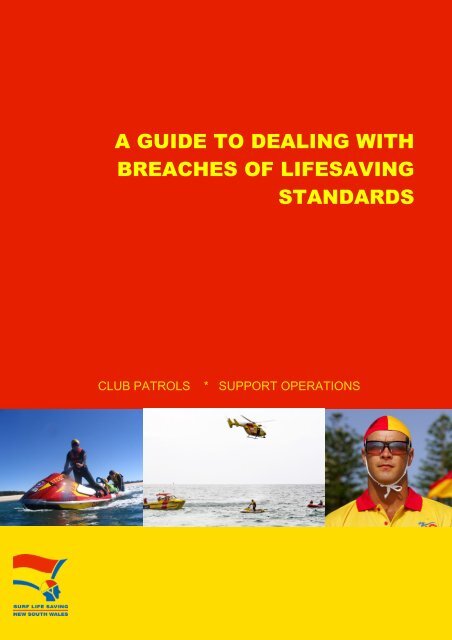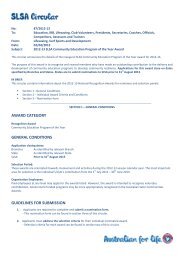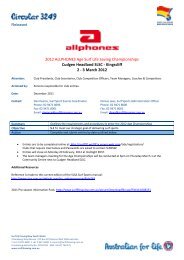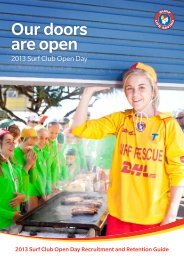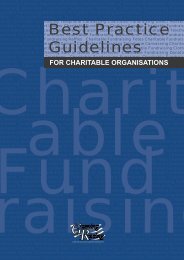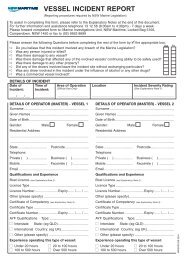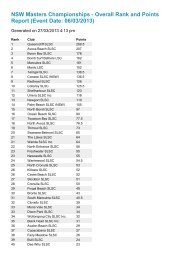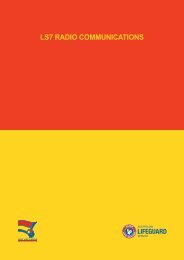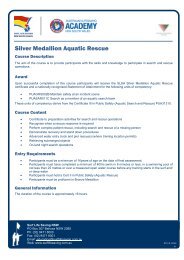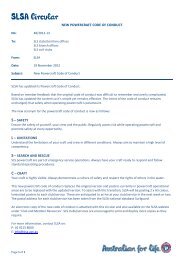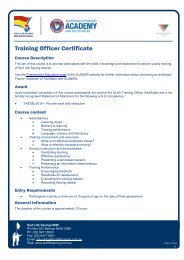a guide to dealing with breaches of lifesaving standards
a guide to dealing with breaches of lifesaving standards
a guide to dealing with breaches of lifesaving standards
Create successful ePaper yourself
Turn your PDF publications into a flip-book with our unique Google optimized e-Paper software.
A GUIDE TO DEALING WITH<br />
BREACHES OF LIFESAVING<br />
STANDARDS<br />
CLUB PATROLS<br />
* SUPPORT OPERATIONS
SLSNSW Guide <strong>to</strong> <strong>dealing</strong> <strong>with</strong> <strong>breaches</strong> <strong>of</strong> <strong>lifesaving</strong> <strong>standards</strong><br />
Version 1<br />
1 st August 2011<br />
This ‘Guide <strong>to</strong> Dealing <strong>with</strong> Breaches <strong>of</strong> Lifesaving Standards’ provides a consistent and structured<br />
process for all levels <strong>of</strong> the organisation <strong>to</strong> follow in order <strong>to</strong> review/assess and respond <strong>to</strong> <strong>breaches</strong> <strong>of</strong><br />
the set <strong>lifesaving</strong> service <strong>standards</strong> in New South Wales.<br />
The <strong>guide</strong>line has been developed in accordance <strong>with</strong> the policy/procedures contained <strong>with</strong>in the<br />
SLSNSW Standard Operating Procedures (Lifesaving Services), Club/Service Lifesaving Service<br />
Agreements and aligns <strong>with</strong> the Constitutions and Regulations <strong>of</strong> SLSNSW and SLSA. This <strong>guide</strong>line is<br />
distributed <strong>with</strong> endorsement <strong>of</strong> the Board <strong>of</strong> SLSNSW.<br />
John Restuccia<br />
Direc<strong>to</strong>r <strong>of</strong> Lifesaving<br />
Surf Life Saving NSW<br />
Dean S<strong>to</strong>rey<br />
Lifesaving Services Manager<br />
Surf Life Saving NSW<br />
© Surf Life Saving NSW 2
SLSNSW Guide <strong>to</strong> <strong>dealing</strong> <strong>with</strong> <strong>breaches</strong> <strong>of</strong> <strong>lifesaving</strong> <strong>standards</strong><br />
CONTENTS<br />
Introduction...........................................................................................................................pg 4<br />
Section A – What constitutes a breach <strong>of</strong> <strong>lifesaving</strong> <strong>standards</strong>..............................................pg 5<br />
Section B – How is the level <strong>of</strong> a breach assessed..................................................................pg 5<br />
Section C – Breach levels (1, 2, 3)...........................................................................................pg 6<br />
Section D – Methods <strong>of</strong> identifying <strong>breaches</strong> <strong>of</strong> <strong>lifesaving</strong> <strong>standards</strong>....................................pg 8<br />
Section E – Process for addressing a breach...........................................................................pg 9<br />
Section F – SLSNSW and Branch Judiciary Guidelines.............................................................pg 11<br />
3
SLSNSW Guide <strong>to</strong> <strong>dealing</strong> <strong>with</strong> <strong>breaches</strong> <strong>of</strong> <strong>lifesaving</strong> <strong>standards</strong><br />
Introduction<br />
Purpose<br />
To provide a consistent structure/process for Clubs/Branches/SLSNSW <strong>to</strong> use when <strong>dealing</strong> <strong>with</strong> <strong>breaches</strong> <strong>of</strong> minimum<br />
<strong>lifesaving</strong> service <strong>standards</strong> – as they pertain <strong>to</strong> the SLSNSW ‘Lifesaving Service Agreements’ and ‘Standard Operating<br />
Procedures’ (SOPs).<br />
Background<br />
By signing a membership form and a club affiliation, SLS members are bound <strong>to</strong> abide by all regulations and the<br />
constitution <strong>of</strong> Branches, SLSNSW and SLSA.<br />
By signing an affiliation form clubs/services and branches are bound <strong>to</strong> abide by all regulations and the constitution <strong>of</strong><br />
SLSNSW and SLSA.<br />
The provision <strong>of</strong> quality <strong>lifesaving</strong> services <strong>to</strong> (or above) an agreed minimum standard is essential <strong>to</strong> ensure public/member<br />
safety and maintain the integrity <strong>of</strong> Surf Life Saving <strong>with</strong>in the emergency services, government sec<strong>to</strong>rs and the general<br />
community.<br />
Breaches <strong>of</strong> <strong>lifesaving</strong> service <strong>standards</strong> put at risk the reputation <strong>of</strong> SLS as a whole and may create unacceptable levels <strong>of</strong><br />
personal risk (injury/death/loss) <strong>to</strong> the public and SLS membership/personnel.<br />
Objectives<br />
The objective <strong>of</strong> this document is <strong>to</strong> provide clear parameters and expectations for all parties - around identification,<br />
communication, support and penalties related <strong>to</strong> delivery below the agreed minimum <strong>standards</strong>.<br />
The document aims <strong>to</strong> provide a process for Clubs, Branches and SLSNSW <strong>to</strong> use <strong>to</strong> address <strong>lifesaving</strong> service standard<br />
<strong>breaches</strong>, in line <strong>with</strong> the relevant constitutions/regulations, namely: SLSA Regulations Section 5 and SLSNSW Constitution<br />
(Sections 2,6,11,17,18) .<br />
It also aims <strong>to</strong> focus primarily on preventative measures and support/assistance <strong>to</strong> ensure quality services, but also<br />
includes disciplinary (penalty) options.<br />
Definitions<br />
Lifesaving Service Agreement- Lifesaving service delivery agreement which includes minimum season length & days <strong>of</strong><br />
patrol, minimum hours <strong>of</strong> service and minimum personnel/qualification requirements. Branches and Clubs may set<br />
minimum requirements as extensions (in addition/above) State minimums.<br />
Standard Operating Procedures (SOP’s) – Operating policies/procedures/<strong>guide</strong>lines for all SLSNSW affiliated <strong>lifesaving</strong><br />
operations (clubs/services).<br />
Clubs / Services: All Surf Life Saving NSW affiliated clubs/services, all Branch and affiliated support operations units (RWC,<br />
ORB, JRB, SurfCom, Aerial Service).<br />
References / Related Documents<br />
SLSA Regulations – Oc<strong>to</strong>ber 2010. Section 5<br />
SLSNSW Constitution; namely: 2(c)(f)(g)(p)(q)(u)(v)(y)(af).6(a-d).11.17(c-e).18.<br />
SLSNSW Lifesaving Service Agreement (branch/club)<br />
SLSNSW Standard Operating Procedures<br />
Annual Patrol Audits/Inspections Program<br />
Annual SLSNSW Compliance Circular<br />
© Surf Life Saving NSW 4
SLSNSW Guide <strong>to</strong> <strong>dealing</strong> <strong>with</strong> <strong>breaches</strong> <strong>of</strong> <strong>lifesaving</strong> <strong>standards</strong><br />
Section A - What constitutes a breach <strong>of</strong> the <strong>lifesaving</strong> <strong>standards</strong>?<br />
Breaches <strong>of</strong> <strong>lifesaving</strong> <strong>standards</strong> primarily relate <strong>to</strong> a failure <strong>to</strong> deliver the minimum obligations as set and agreed by all<br />
parties <strong>with</strong>in a club/service Lifesaving Service Agreement and the SLSNSW Standard Operating Procedures (SOP’s).<br />
‘Breaches’ would emerge most commonly as one or a combination <strong>of</strong> the following events:<br />
Breach - Service Provision<br />
Failure <strong>of</strong> a club/service <strong>to</strong> deliver a <strong>lifesaving</strong> service on a pre-designated day/period, incl:<br />
- The late opening <strong>of</strong> patrol – after minimum start time<br />
- The early closure <strong>of</strong> patrol - prior <strong>to</strong> minimum finish time<br />
- No service provision for the entire required period<br />
As set in a club/service Lifesaving Service Agreement and SLSNSW Constitution - Section 6.<br />
Breach - Personnel / Qualifications<br />
Inadequate number <strong>of</strong> personnel <strong>to</strong> meet minimum requirements for staging a patrol (state or branch minimums)<br />
Lack <strong>of</strong> qualified personnel <strong>to</strong> meet minimum requirements for staging a patrol (i.e. no first aid or IRB qualified<br />
personnel)<br />
Lack <strong>of</strong> minimum equipment on patrol (i.e. no AED or IRB)<br />
As set in a club/service Lifesaving Service Agreement and SLSNSW Standard Operating Procedures.<br />
Misconduct / Negligence<br />
Misuse/dangerous use <strong>of</strong> equipment (i.e ATV, IRB etc)<br />
As set in a club/service Lifesaving Service Agreement, SLSNSW Standard Operating Procedures, Maritime Regulations,<br />
State/Federal Law.<br />
Section B: How is the level (seriousness) <strong>of</strong> a breach assessed?<br />
The level (seriousness) <strong>of</strong> a breach is assessed against ‘risk’ using a standard risk assessment/management framework -<br />
pertaining <strong>to</strong> likelihood and consequence <strong>of</strong> the issue/action <strong>to</strong> cause injury/loss.<br />
Risk Considerations<br />
<br />
<br />
<br />
<br />
Risk <strong>to</strong> the public<br />
Where the breach creates increased risk <strong>to</strong> the public <strong>of</strong> injury or death<br />
Risk <strong>to</strong> membership<br />
Where the breach creates increased risk <strong>to</strong> the membership <strong>of</strong> injury <strong>of</strong> death<br />
Risk <strong>to</strong> the organisation<br />
Where the breach creates increased risk <strong>to</strong> the organisations image/credibility/integrity <strong>with</strong> key stakeholders<br />
(community/government/sponsors/emergency services)<br />
Contributing/Causal Fac<strong>to</strong>r<br />
Where the breach has contributed <strong>to</strong>o or caused loss (disrepute/injury/death)<br />
Frequency<br />
<br />
<br />
Frequency should be considered for repeated minor (level 1) <strong>breaches</strong> – where ongoing/unresolved negative trends<br />
are identified<br />
Moderate-High (level 2/3) <strong>breaches</strong> are cause for more immediate action, and repeat occurrences <strong>of</strong> such would be<br />
cause for serious consideration/review<br />
5
SLSNSW Guide <strong>to</strong> <strong>dealing</strong> <strong>with</strong> <strong>breaches</strong> <strong>of</strong> <strong>lifesaving</strong> <strong>standards</strong><br />
Section C: Breach Levels (1, 2, 3)<br />
This 3-tier structure provides a ‘risk-based’ model <strong>to</strong> assist in identifying and acting on various <strong>breaches</strong> in a consistent<br />
manner.<br />
Level 1<br />
Continued minor <strong>breaches</strong> <strong>of</strong> SOP’s (patrol <strong>standards</strong> etc), resulting in:<br />
<br />
<br />
Safety Risk: No immediate threat <strong>of</strong> injury <strong>to</strong> members or public<br />
Organisation Risk: Minor risk <strong>to</strong> organisation image/integrity<br />
A club/service will reach ‘Level 1’ after repeat documented instances <strong>of</strong> failing a patrol audit/inspection and/or having<br />
substandard equipment or patrolling <strong>standards</strong>.<br />
Examples include (but not limited <strong>to</strong>o) ongoing instances <strong>of</strong>:<br />
- Poor uniform <strong>standards</strong><br />
- Sub-standard equipment on patrol<br />
- Poor beach management <strong>standards</strong><br />
- Inappropriate use <strong>of</strong> radio network<br />
Repeated Offences<br />
Further <strong>breaches</strong> <strong>with</strong>in a 12 month period may be elevated <strong>to</strong> a Level 2 breach review.<br />
Level 2<br />
Failure <strong>to</strong> maintain/provide appropriate minimum <strong>standards</strong>, in breach <strong>of</strong> Lifesaving Service Agreement and SOP’s;<br />
resulting in:<br />
Safety Risk: Increased risk <strong>of</strong> injury/death <strong>to</strong> public/members<br />
Organisation Risk: Organisation brought in<strong>to</strong> disrepute<br />
Examples include (but not limited <strong>to</strong>o):<br />
Repeated Level 1 <strong>breaches</strong><br />
Late commencement <strong>of</strong> patrol / early closure <strong>of</strong> patrol<br />
Patrol numbers / qualifications below minimum requirements<br />
Unreported non-operational core equipment (i.e. IRB, AED, O2)<br />
Misconduct on patrol (inappropriate/dangerous use <strong>of</strong> vessels, vehicles, medicines, equipment, public address<br />
systems, public signage)<br />
Repeated Offences<br />
Further <strong>breaches</strong> <strong>with</strong>in a 12 month period may be elevated <strong>to</strong> a Level 3 breach review<br />
© Surf Life Saving NSW 6
SLSNSW Guide <strong>to</strong> <strong>dealing</strong> <strong>with</strong> <strong>breaches</strong> <strong>of</strong> <strong>lifesaving</strong> <strong>standards</strong><br />
Level 3<br />
Failure <strong>to</strong> maintain/provide appropriate minimum <strong>standards</strong> in breach <strong>of</strong> a clubs/service Lifesaving Service Agreement<br />
and/or SLSNSW SOP’s, resulting in:<br />
Safety Risk: Significant threat <strong>of</strong> injury/death <strong>to</strong> the public/members, and/or injury/death occurs which is related <strong>to</strong><br />
the breach<br />
Organisation risk: Organisation is brought in<strong>to</strong> disrepute<br />
Examples include (but not limited <strong>to</strong>o):<br />
- Repeated Level 2 <strong>breaches</strong><br />
- Non staging <strong>of</strong> patrol (patrol no-show)<br />
- Late commencement <strong>of</strong> patrol / early closure <strong>of</strong> patrol which results in injury/death at that location<br />
- Patrol numbers / qualifications below minimum requirements during an injury/death incident<br />
- Unreported non-operational core equipment (i.e. IRB, AED, O2) during an injury/death incident<br />
- Substantiated serious misconduct on patrol causing or contributing <strong>to</strong>o injury/death (inappropriate/dangerous use <strong>of</strong><br />
vessels, vehicles, medicines, equipment, public address systems, public signage)<br />
Repeated Offences<br />
Further <strong>breaches</strong> shall be addressed in due consideration <strong>with</strong> previous <strong>breaches</strong> for a 24 month period.<br />
7
SLSNSW Guide <strong>to</strong> <strong>dealing</strong> <strong>with</strong> <strong>breaches</strong> <strong>of</strong> <strong>lifesaving</strong> <strong>standards</strong><br />
Section D: Methods <strong>of</strong> identifying <strong>breaches</strong> <strong>of</strong> <strong>lifesaving</strong> <strong>standards</strong><br />
1. Pre-Identification<br />
Context: Where a club/service can foresee that a ‘breach’ is likely, before it occurs (prior <strong>to</strong> or during patrol).<br />
The club/service should contact the one or more <strong>of</strong> the following <strong>to</strong> request support/assistance:<br />
<br />
<br />
<br />
<br />
The Branch Direc<strong>to</strong>r <strong>of</strong> Lifesaving<br />
SurfCom<br />
The Branch Duty Officer (or equivalent)<br />
The Branch Manager/CEO (Staff)<br />
These personnel shall activate the necessary branch/club resources (incl neighbouring clubs, support operations etc) <strong>to</strong><br />
assist the club in service delivery in the short-term.<br />
This short-term action should correspond <strong>with</strong> the wider goal <strong>to</strong> identify any internal club issues and formulate strategies<br />
<strong>to</strong> remedy/rectify ‘root-cause’.<br />
2. Patrol Sign-On (SurfCom)<br />
Context: Where SurfCom conducts radio checks and records patrol sign-on and resource confirmation.<br />
If a <strong>lifesaving</strong> service fails <strong>to</strong> sign-on and are subsequently uncontactable (not on-duty) or if the resources communicated<br />
fall short <strong>of</strong> required minimums (#’s <strong>of</strong> personnel, equipment available etc).<br />
SurfCom/Duty Officer should:<br />
a) Contact the Patrol Captain (if available) <strong>to</strong> confirm details and what actions are being taken <strong>to</strong> remedy the issue<br />
b) Contact the Club Captain <strong>to</strong> communicate the issue and what actions are being taken<br />
c) Contact the Branch Direc<strong>to</strong>r <strong>of</strong> Lifesaving or Duty Officer and liaise <strong>with</strong> this person and the Club Captain <strong>to</strong> organise<br />
assistance and resolve the issue<br />
3) Patrol Audits/Inspection<br />
Context: Where a Branch or State patrol audit/inspection is conducted and the Club/Service is found <strong>to</strong> be in breach <strong>of</strong><br />
their Lifesaving Service Agreement and/or SOP’s.<br />
The Patrol Audi<strong>to</strong>r/Inspec<strong>to</strong>r should:<br />
a) Contact the Branch Duty Officer or Direc<strong>to</strong>r <strong>of</strong> Lifesaving and communicate the issue<br />
b) The Branch Direc<strong>to</strong>r <strong>of</strong> Lifesaving or Duty Officer shall then liaise <strong>with</strong> the Club Captain <strong>to</strong> organise assistance and<br />
resolve the immediate issue (if able)<br />
This short-term action should correspond <strong>with</strong> the wider goal <strong>to</strong> identify any internal club issues and formulate strategies<br />
<strong>to</strong> remedy/rectify ‘root-cause’.<br />
Note: Branch/State Officer beach visits (not formal audits) shall also constitute a ‘method’ <strong>of</strong> identification<br />
4) Critical / Major Incidents<br />
Context: Where a critical/major incident occurs at a location, and where serious harm may or may not have occurred <strong>to</strong> a<br />
member <strong>of</strong> the public or SLS member.<br />
The Branch or State Direc<strong>to</strong>r <strong>of</strong> Lifesaving, Duty Officer (or their delegated <strong>of</strong>ficer) shall:<br />
a) Undertake an investigation <strong>of</strong> the sequence <strong>of</strong> events, roles/responsibilities, contributing fac<strong>to</strong>rs and complete all<br />
required SLS paperwork.<br />
b) Report the details/outcomes <strong>of</strong> the incident <strong>to</strong> the relevant parties ASAP<br />
© Surf Life Saving NSW 8
SLSNSW Guide <strong>to</strong> <strong>dealing</strong> <strong>with</strong> <strong>breaches</strong> <strong>of</strong> <strong>lifesaving</strong> <strong>standards</strong><br />
Section E: Process for addressing a breach<br />
This section outlines how a breach <strong>of</strong> <strong>lifesaving</strong> <strong>standards</strong> should be addressed.<br />
Risk Mitigation – Real Time<br />
Where a breach is identified during patrol hours, the Patrol Audi<strong>to</strong>r/SurfCom Opera<strong>to</strong>r/Duty Officer/Direc<strong>to</strong>r <strong>of</strong> Lifesaving<br />
will attempt <strong>to</strong> resolve the issues <strong>with</strong> the Patrol Captain and Club Captain ASAP (see Section D).<br />
Level 1 Breach – Club / Branch Responsibility<br />
The recorded details <strong>of</strong> the breach should be sent <strong>to</strong> the Club/Service Captain and President <strong>with</strong>in 7 days <strong>of</strong> notification at<br />
Branch.<br />
The club/service should be requested <strong>to</strong> outline <strong>to</strong> the Branch <strong>with</strong>in 30 days <strong>of</strong> receiving notification, the following:<br />
- The reasons for the breach/es<br />
- What measures the club/service will/are taking <strong>to</strong> prevent a repeat occurrence (and how it will maintain a system <strong>of</strong><br />
compliance checking)<br />
- What disciplinary action the club is taking internally<br />
The Branch should:<br />
- Identify options <strong>to</strong> provide support <strong>to</strong> resolve the issues<br />
- Identify a process <strong>of</strong> checks <strong>to</strong> ensure ongoing support is provided and that consistent review is undertake <strong>to</strong> measure<br />
progress/compliance<br />
- Identify whether any disciplinary action may be required<br />
- Maintain a record <strong>of</strong> the breach on file for at least 12 months<br />
Level 2 Breach – Club / Branch Responsibility<br />
The recorded details <strong>of</strong> the breach should be sent <strong>to</strong> Club/Service Captain and President <strong>with</strong>in 48hours <strong>of</strong> notification at<br />
Branch.<br />
The club/service should be requested <strong>to</strong> outline <strong>to</strong> the Branch <strong>with</strong>in 14 days <strong>of</strong> receiving notification, the following:<br />
- The reasons for the breach<br />
- What measures the club/service will/are taking <strong>to</strong> prevent a repeat occurrence (and how it will maintain a system <strong>of</strong><br />
compliance checking)<br />
- What action the club is taking internally<br />
- What action the club believes branch or state should take<br />
The Direc<strong>to</strong>r <strong>of</strong> Lifesaving (Branch) or nominated Branch Officer should investigate the breach and notify the Club and the<br />
Branch Executive/Board on:<br />
- Whether a breach has occurred<br />
- Whether they deem the breach as serious in nature<br />
- What action they recommend<br />
- Recommended initiatives <strong>to</strong> prevent repeat occurrences<br />
The Branch should:<br />
- Identify options <strong>to</strong> provide support <strong>to</strong> resolve the issues<br />
- Identify a process <strong>of</strong> checks <strong>to</strong> ensure ongoing support is provided and that consistent review is undertake <strong>to</strong> measure<br />
progress/compliance<br />
- Ensure a process is in place <strong>to</strong> address any preventable <strong>breaches</strong> prior <strong>to</strong> them occurring<br />
- Consider referring the issue <strong>to</strong> the Branch Judiciary - <strong>to</strong> identify and implement any appropriate penalties (and advise<br />
SLSNSW if required)<br />
- Maintain a record <strong>of</strong> the breach on file for at least 12 months<br />
9
SLSNSW Guide <strong>to</strong> <strong>dealing</strong> <strong>with</strong> <strong>breaches</strong> <strong>of</strong> <strong>lifesaving</strong> <strong>standards</strong><br />
Level 3 Breach – Club / Branch / State Responsibility<br />
Notification<br />
The Club shall notify the Branch (SurfCom/Duty Officer & Direc<strong>to</strong>r <strong>of</strong> Lifesaving) immediately after the breach/incident<br />
occurring<br />
Branch shall notify SLSNSW <strong>with</strong>in 48 hours (ASAP) <strong>of</strong> its notification<br />
Investigation<br />
The Direc<strong>to</strong>r <strong>of</strong> Lifesaving (Branch) or nominated Branch Officer will begin <strong>to</strong> investigate the breach ASAP<br />
SLSNSW may elect <strong>to</strong> assist the Branch and/or conduct its own investigation if necessary<br />
The Branch and/or State Direc<strong>to</strong>r <strong>of</strong> Lifesaving (or nominated Officer) shall report their findings <strong>to</strong> the Club, Branch and<br />
State, outlining:<br />
- Whether a breach has occurred<br />
- Whether they deem the breach as serious in nature<br />
- What action they recommend<br />
- Recommended initiatives <strong>to</strong> prevent repeat occurrences<br />
The Branch and/or State will:<br />
- Identify options <strong>to</strong> provide support <strong>to</strong> resolve the issues<br />
- Identify a process <strong>of</strong> checks <strong>to</strong> ensure ongoing support is provided and that consistent review is undertake <strong>to</strong> measure<br />
progress/compliance<br />
- Ensure a process is in place <strong>to</strong> address any preventable <strong>breaches</strong> prior <strong>to</strong> them occurring<br />
- Refer the issue <strong>to</strong> the Branch (or State) judiciary - <strong>to</strong> identify and implement any appropriate actions and/or penalties<br />
- Maintain a record <strong>of</strong> the breach on file for at least 24 months<br />
© Surf Life Saving NSW 10
SLSNSW Guide <strong>to</strong> <strong>dealing</strong> <strong>with</strong> <strong>breaches</strong> <strong>of</strong> <strong>lifesaving</strong> <strong>standards</strong><br />
Section F: SLSNSW and Branch Judiciary Guidelines<br />
A Level 3 breach is deemed serious in nature and warrants review by a Branch and/or State Judiciary.<br />
Branch and State Judiciary requirements and processes shall be as per the relevant and binding Branch/State/National<br />
regulations and constitutions.<br />
Penalty Guidelines<br />
In addition <strong>to</strong> providing operational and development support <strong>to</strong> a club/service, Branch and/or State may apply penalties as<br />
deemed appropriate through a judicial process.<br />
Penalties should align <strong>with</strong> SLSNSW compliancy requirements - which may include (but are not limited <strong>to</strong>o):<br />
<br />
<br />
<br />
<br />
Restriction <strong>of</strong> funding/grants<br />
Tagged or State/Branch administered funding/grants (<strong>to</strong> address breach, i.e. equipment issues)<br />
Restriction <strong>of</strong> recognition awards (awards <strong>of</strong> excellence etc) – not training awards/qualifications<br />
Restriction <strong>of</strong> competition/event participation<br />
Appeals<br />
Any individual/club/service may appeal the decision under its rights set out in the regulations/constitution.<br />
Tiered Penalty Guidelines<br />
Level 1 Breach<br />
Continued minor <strong>breaches</strong> <strong>of</strong> SOP’s (patrol <strong>standards</strong> etc), resulting in:<br />
<br />
<br />
Safety Risk: No immediate threat <strong>of</strong> injury <strong>to</strong> members or public<br />
Organisation Risk: Minor risk <strong>to</strong> organisation image/integrity<br />
Penalties may include:<br />
- Grants/funding tagged/administered by Branch/State <strong>to</strong> correct breach (i.e. equipment)<br />
Level 2 Breach<br />
Failure <strong>to</strong> maintain/provide appropriate minimum <strong>standards</strong>, in breach <strong>of</strong> Lifesaving Service Agreement and SOP’s;<br />
resulting in:<br />
<br />
<br />
Safety Risk: Increased risk <strong>of</strong> injury/death <strong>to</strong> public/members<br />
Organisation Risk: Organisation brought in<strong>to</strong> disrepute<br />
Penalties (for up <strong>to</strong> 6 months) may include:<br />
- Ineligibility for grants/funding<br />
- Grants/funding tagged/administered by Branch/State <strong>to</strong> correct breach (i.e. equipment)<br />
- Suspension from surf sports competition/representation<br />
- Ineligibility for recognition awards such as those presented at the ‘Awards <strong>of</strong> Excellence’ (Branch/State/National) – not<br />
training awards/qualifications<br />
11
SLSNSW Guide <strong>to</strong> <strong>dealing</strong> <strong>with</strong> <strong>breaches</strong> <strong>of</strong> <strong>lifesaving</strong> <strong>standards</strong><br />
Level 3 Breach<br />
Failure <strong>to</strong> maintain/provide appropriate minimum <strong>standards</strong> in breach <strong>of</strong> the Lifesaving Service Agreement and SOP’s,<br />
resulting in:<br />
<br />
<br />
Safety Risk: Significant threat <strong>of</strong> injury/death <strong>to</strong> the public/members, and/or injury/death occurs which is related <strong>to</strong> the<br />
breach.<br />
Organisation risk: Organisation is brought in<strong>to</strong> disrepute.<br />
Penalties (for up <strong>to</strong> 12 months) may include:<br />
- Ineligibility for grants/funding<br />
- Grants/funding tagged/administered by Branch/State <strong>to</strong> correct breach (i.e. equipment)<br />
- Suspension from surf sports competition/representation<br />
- Ineligibility for recognition awards (Branch/State/National) – not training awards/qualifications<br />
- Individual member suspension from organisation<br />
Penalties options beyond 12 months<br />
- Individual member expulsion from organisation<br />
- Club/service suspension from the organisation pending affiliation review<br />
© Surf Life Saving NSW 12
SLSNSW Guide <strong>to</strong> <strong>dealing</strong> <strong>with</strong> <strong>breaches</strong> <strong>of</strong> <strong>lifesaving</strong> <strong>standards</strong><br />
13


